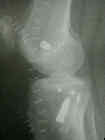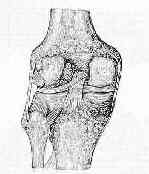- Discussion:
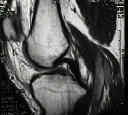
- Anatomy and Function of PCL:
- mechanism of injury:
- fall on a flexed knee with plantar flexed ankle;
- associated injuries:
- ACL and collateral ligament injury (knee dislocation);
- when PCL injury occurs w/ MCL injury, expect large increase in valgus instability when the knee is in full extension;
- tibial plateau rim fractures:
- when these occur with PCL injuries, there is often a severe combined ligament injury or dislocation;
- posterolateral knee instability;
- it is important to distinguish this type of instability from one plane posterior instability;
- isolated PCL reconstruction will not correct the rotatory instability and will only partially correct the the one
plane instability (since the tendency to externally rotate results in relative shortening of PCL origin
and insertion causing ligament laxity);
- chondral injuries of the knee (when a dashboard injury is involved);

- Management of PCL Tears:
- Examination of the PCL
- Radiographs:
- Accuracy of stress radiography techniques in grading isolated and combined posterior knee injuries: a cadaveric study.
- Stress radiography for quantifying posterior cruciate ligament deficiency. 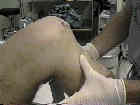
- MRI Findings:
- references:
- The accuracy of selective magnetic resonance imaging compared with the findings of arthroscopy of the knee.
- Medial Segond-type fracture: cortical avulsion off the medial tibial plateau associated with tears of the posterior cruciate ligament and medial meniscus.
- Prognosis / Non Operative Treatment:
- w/ isolated tear prognosis is generally considered to be favorable except for the long term possibility of patellofemoral arthrosis;
- indications for non op treatment include chronic injury in older less active patients, or an isolated grade 2 injury (tibial surface flush
w/ surface of femoral condyle;
- remember that PCL tears from a hyperflexion mechanism will most commonly cause a tear of the larger anterolateral where as
PM band remains intact (which is loose in flexion);
- this type injury does not involve the secondary restraints and does well with non operative treatment;
- references:
- Natural history of the posterior cruciate ligament-deficient knee.
- The cruciate ligaments of the knee. Anatomical, functional, and experimental analysis.
- Conservative treatment of isolated injuries to the posterior cruciate ligament in athletes.
- Arthroscopic evaluation of articular cartilage lesions in posterior-cruciate-ligament-deficient knees.
- Subjective results of nonoperatively treated, acute, isolated posterior cruciate ligament injuries.
- Biomechanical verification that PCL reconstruction is unnecessary in the muscle-stabilized knee.
- In Vivo Analysis of the Isolated Posterior Cruciate Ligament-Deficient Knee During Functional Activities
- Successful return to sports in athletes following non-operative management of acute isolated posterior cruciate ligament injuries: medium-term follow-up.
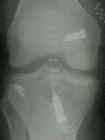
- Operative Treatment of PCL Tear:
- indications for operative treatment:
- acute injuries;
- active young patient;
- either isolated grade 3 tears (anterior border of tibia is posterior to femoral condyles) or
combined injury such as grade 2 injury (tibial surface and the femoral condyles are
flush) along with posterolateral instability;
- References:
Current Concepts Review. Injuries of the Posterior Cruciate Ligament.
Posterior tibial subluxation of the posterior cruciate-deficient knee.
Long-term followup of posterior cruciate ligament rupture: a study of 116 cases.


